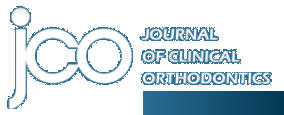THE EDITOR'S CORNER50 Weeks to Our 50thDAVID S. VOGELSLike almost every U.S. orthodontist, JCO maintains a Facebook page as one means of connecting with its customer base—in your case, patients; in ours, readers. The format doesn’t necessarily lend itself to dispensing clinical information, although we have recently begun posting helpful videos related to our published Pearls. We tend to get the most likes and shares from our monthly profiles of finalists for the Eugene L. Gottlieb JCO Student of the Year Award (the most recent winner was announced in the March 2017 issue), no doubt because of these students’ extended networks of relatives and colleagues. But the 50th-anniversary year of the journal has brought us an opportunity for a new and unique Facebook venture. |
257 | ||
THE CUTTING EDGEEffects of Photodynamic Therapy on the Clinical and Biomechanical Efficiency of Mini-Implants: A Randomized Controlled TrialRAJ KUMAR MAURYA MDS, ANKUR GUPTA MDS, HARPREET SINGH MDS, SURBHI THAKKAR MDS, HARSH ASHOK MISHRA MDSPhotobiomodulation (PBM) and photobiomodulation therapy (PBMT) are two terms we are hearing more about in our profession and other areas of health care. We see various devices, some over-the-counter, using PBMT to treat acne, wrinkles, hair loss, and pain. PBMT is also being applied for smoking cessation, weight loss, addiction therapy, nerve regeneration, and more. Current research is investigating its use to mitigate the effects of Alzheimer’s and Parkinson’s diseases. It seems almost too good to be true, but studies on the effects of light in the red-to-infrared range (600-1,070nm) have validated PBMT’s effects on a cellular level. |
259 | ||
Spring-Assisted Molar Intrusion in Clear-Aligner TreatmentMENG-JIAO RUAN DDS, RUO-PING JIANG DDS, PhDAlthough fixed appliances with either continuous or segmented archwires are an effective method of intruding teeth, extrusion of the adjacent anchorage teeth is inevitable in most cases. In recent yea... |
270 | ||
Targeted Mechanics for Treatment of Patients with Severe Short-Root AnomalyELIANE H. DUTRA DDS, MSD, PhD, NANDAKUMAR JANAKIRAMAN DDS, MDS, RAVINDRA NANDA BDS, MDS, PhD, FLAVIO A. URIBE DDS, MDSShort-root anomaly (SRA), which was first described by Lind in 1972,1 is characterized by abnormally short and plump roots.1,2 It is commonly misdiagnosed as root resorption, but is in fact a developm... |
279 | ||
Miniscrew-Supported Orthodontic Pseudo-Ankylosis for Mesialization of a Lower Third MolarNICOLA DERTON DMD, DANIELA LUPINI DMD, MAURO COZZANI DMD, MScDAdult orthodontic treatment sometimes requires lower third-molar uprighting and mesialization. In the past, to avoid unwanted reciprocal movement of the anchorage unit, absolute anchorage could be obt... |
290 | ||
PEARLSMeasuring Bonded Lingual RetainersNEAL D. KRAVITZ DMD, MS, JEFFREY M. SHIRCK DDS, MSMultistranded lingual retainers are commonly “eyeball” measured for length during bonding, which can result in a retainer that is too long or too short. The time needed to cut a new retainer wire exte... |
294 | ||
CASE REPORTSimultaneous Phase I Expansion and Ectopic Molar Correction with a Hyrax-Halterman ApplianceCHRISTOPHER A. TEETERS DMD, MSCorrection of ectopic molars is further complicated by transverse arch constriction.1,2 In such a case, a coil spring on a segmental archwire from the second deciduous molar to the first molar can be ... |
295 | ||
Product News Published in May 2017
|
305 |
Like almost every U.S. orthodontist, JCO maintains a Facebook page as one means of connecting with its customer base—in your case, patients; in ours, readers. The format doesn’t necessarily lend itself to dispensing clinical information, although we have recently begun posting helpful videos related to our published Pearls. We tend to get the most likes and shares from our monthly profiles of finalists for the Eugene L. Gottlieb JCO Student of the Year Award (the most recent winner was announced in the March 2017 issue), no doubt because of these students’ extended networks of relatives and colleagues. But the 50th-anniversary year of the journal has brought us an opportunity for a new and unique Facebook venture.
Photobiomodulation (PBM) and photobiomodulation therapy (PBMT) are two terms we are hearing more about in our profession and other areas of health care. We see various devices, some over-the-counter, using PBMT to treat acne, wrinkles, hair loss, and pain. PBMT is also being applied for smoking cessation, weight loss, addiction therapy, nerve regeneration, and more. Current research is investigating its use to mitigate the effects of Alzheimer’s and Parkinson’s diseases. It seems almost too good to be true, but studies on the effects of light in the red-to-infrared range (600-1,070nm) have validated PBMT’s effects on a cellular level.
Although fixed appliances with either continuous or segmented archwires are an effective method of intruding teeth, extrusion of the adjacent anchorage teeth is inevitable in most cases. In recent yea...
Short-root anomaly (SRA), which was first described by Lind in 1972,1 is characterized by abnormally short and plump roots.1,2 It is commonly misdiagnosed as root resorption, but is in fact a developm...
Adult orthodontic treatment sometimes requires lower third-molar uprighting and mesialization. In the past, to avoid unwanted reciprocal movement of the anchorage unit, absolute anchorage could be obt...
Multistranded lingual retainers are commonly “eyeball” measured for length during bonding, which can result in a retainer that is too long or too short. The time needed to cut a new retainer wire exte...
Correction of ectopic molars is further complicated by transverse arch constriction.1,2 In such a case, a coil spring on a segmental archwire from the second deciduous molar to the first molar can be ...
This is currently not available. Please check back later.
Please contact heather@jco-online.com for any changes to your account.

